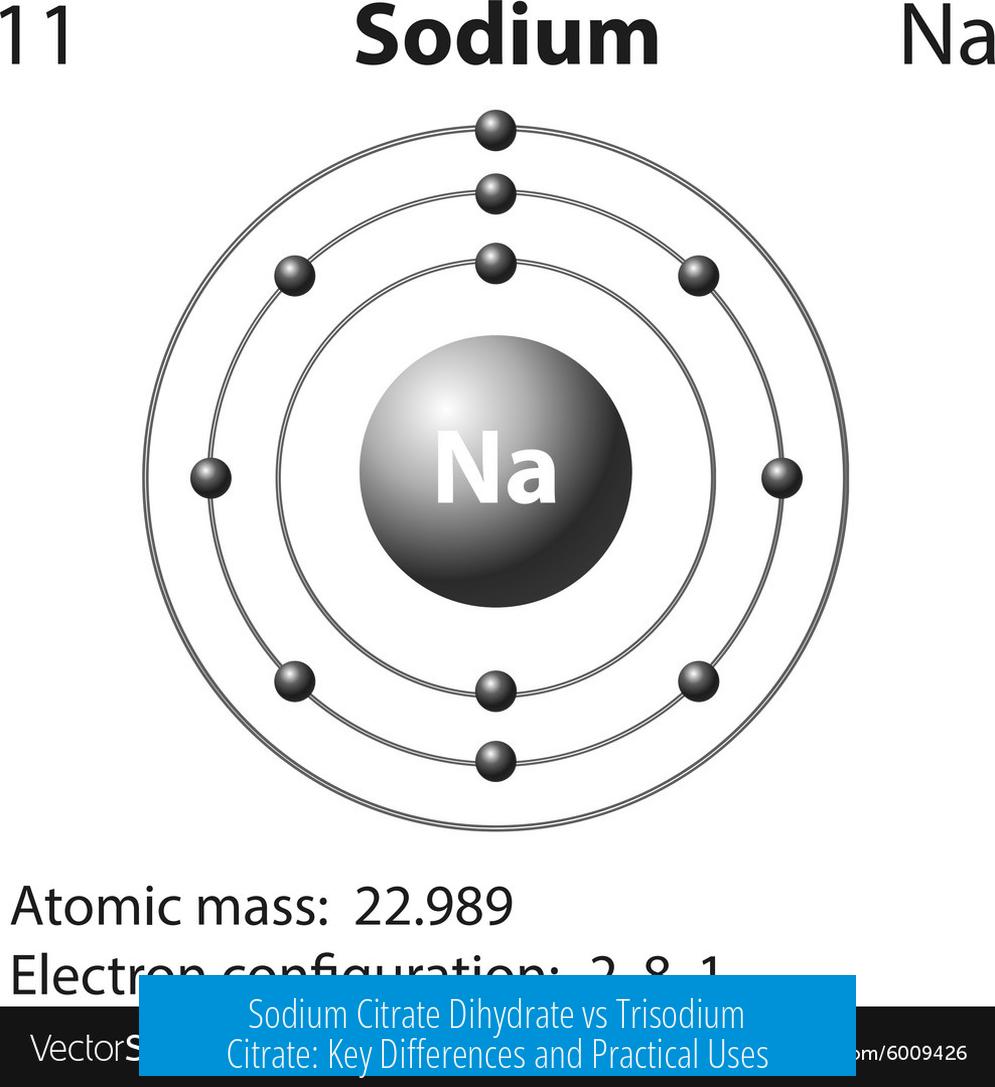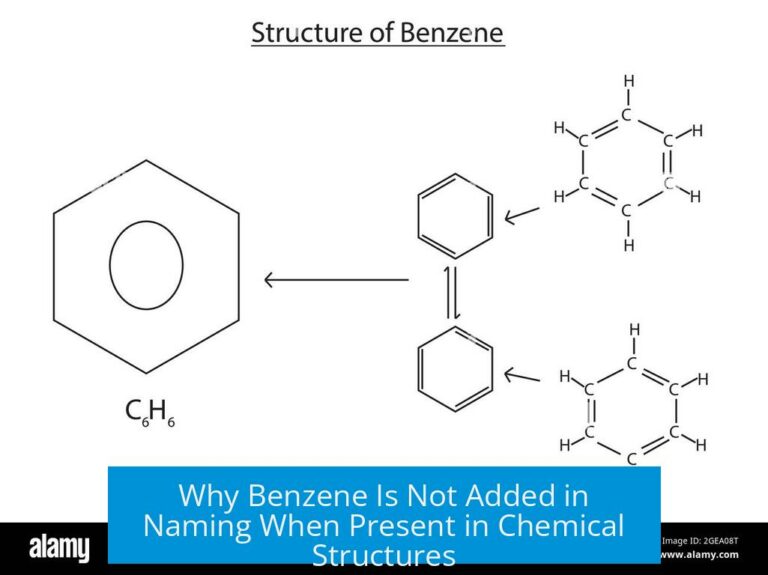Sodium Citrate Dihydrate vs Trisodium Citrate: A Detailed Comparison
Sodium citrate dihydrate and trisodium citrate refer to similar chemical species but differ mainly in their hydration state and nomenclature precision. The key difference lies in water content within the crystal structure of the dihydrate form, affecting molar mass and practical usage. Trisodium citrate explicitly defines the sodium-to-citrate ratio (3:1), which sodium citrate implies. The dihydrate form includes two water molecules per formula unit, requiring mass and concentration adjustments when used.
1. Chemical Composition and Naming
1.1 Sodium Citrate and Trisodium Citrate: Identical or Different?
Trisodium citrate and sodium citrate commonly refer to the same compound. Trisodium citrate explicitly communicates that three sodium ions (Na+) balance one citrate ion (C6H5O73−), maintaining electrical neutrality. The “tri” prefix clarifies the stoichiometric ratio, essential in scientific precision.
In most food and pharmaceutical contexts, sodium citrate is synonymous with trisodium citrate because it must maintain this 3:1 ion ratio for charge balance. The citrate ion carries a -3 charge, matching three sodium ions with +1 charge each. This equivalence is widely accepted, including by authoritative sources such as Wikipedia.
1.2 Why Use “Tri” in Trisodium Citrate?
The “tri” prefix helps prevent ambiguity where citrate ions could potentially have varied charge states or stoichiometries. This distinction might matter in technical or industrial chemistry contexts. However, in commercial and food applications, sodium citrate nearly always refers to trisodium citrate.
2. Hydration Status: Dihydrate vs Anhydrous Form
2.1 What Does “Dihydrate” Mean?
The term “dihydrate” indicates the material contains two water molecules chemically bound to each formula unit of trisodium citrate. These water molecules are part of the crystal lattice and influence the physical and chemical properties of the compound.
In contrast, the anhydrous form lacks this water, resulting in a different molar mass and density.
2.2 Impact on Molar Mass and Ion Content
| Form | Molar Mass (g/mol) | Water Molecules | Effect on Ion Content per Gram |
|---|---|---|---|
| Anhydrous Trisodium Citrate | 258.06 | 0 | Higher sodium and citrate ion content per gram |
| Trisodium Citrate Dihydrate | 294.10 (approx.) | 2 | Lower ion content per gram due to water weight |
The presence of two water molecules increases molar mass by about 36 g/mol. Consequently, when weighing trisodium citrate dihydrate, one obtains fewer active citrate and sodium ions per gram compared to anhydrous trisodium citrate.
2.3 Practical Consequences for Concentration and Mass Calculations
When the exact citrate concentration matters—for instance, in pharmaceutical formulations or lab preparations—users must adjust the mass of the dihydrate to deliver equivalent amounts of citrate ions as the anhydrous form. This adjustment prevents under-dosing or errors in solution molarity.
For example, to achieve 1 gram of anhydrous trisodium citrate, roughly 1.14 grams of the dihydrate will be required, reflecting the added mass from water molecules.
3. Commonality and Practical Considerations
3.1 Availability of Forms in Commerce
The dihydrate form is commercially dominant because anhydrous trisodium citrate readily absorbs moisture and converts into the dihydrate. This hygroscopic nature challenges the storage and handling of the anhydrous form.
Most suppliers and retailers list sodium citrate as the dihydrate. Online listings, including those on platforms like Amazon, tend to stock the dihydrate as standard. The dihydrate’s stability and ease of handling support its widespread availability.
3.2 Application Implications
- Dihydrate is commonly used in food, pharmaceuticals, and laboratory reagents.
- When precise molar concentrations or pH buffering capacities are critical, stakeholders should note hydration state effects.
- In formulations requiring exact weight or molarity, the user must convert weights between forms accurately.
4. Additional Notes
4.1 Confirmation from External References
Reliable references, like the Wikipedia article on trisodium citrate, affirm that the terms sodium citrate and trisodium citrate are often interchangeable in practice. The naming convention reflects scientific clarity rather than a difference in chemical identity (beyond hydration).
4.2 Comparison with Other Antacids
Sodium citrate finds use as a buffering agent and antacid. When compared to alternatives such as sodium bicarbonate (baking soda) and calcium carbonate (found in Tums), sodium citrate acts more mildly. Sodium bicarbonate and calcium carbonate generate carbon dioxide gas during acid neutralization, which can cause belching. Sodium citrate generally avoids this side effect.
This functional difference explains occasional preference for sodium citrate in medical and food contexts where reducing gas formation is desirable.
Key Takeaways
- Sodium citrate generally refers to trisodium citrate, specifying a 3:1 sodium-to-citrate ion ratio.
- The dihydrate form contains two water molecules per formula unit, increasing molar mass and decreasing ion content per gram.
- Users must adjust mass calculations when substituting dihydrate for anhydrous trisodium citrate to ensure accurate citrate dosing.
- The dihydrate form is more common commercially due to its stability and resistance to moisture absorption.
- Confirmed by authoritative sources, sodium citrate and trisodium citrate are chemically the same except for hydration state.
- Sodium citrate acts as a gentle antacid with fewer side effects compared to baking soda or calcium carbonate.
What is the difference between sodium citrate and trisodium citrate?
They are essentially the same compound.
“Trisodium” specifies three sodium ions per citrate ion. Without “tri,” the ratio is implied due to charge balance. In most cases, sodium citrate means trisodium citrate.
How does the dihydrate form differ from anhydrous trisodium citrate?
The dihydrate form contains two water molecules integrated into its crystal structure.
This increases its molar mass, so per gram, it has fewer sodium and citrate ions compared to the anhydrous form.
Why must the mass used be adjusted when using trisodium citrate dihydrate?
The water in the dihydrate adds extra mass but no active ions.
To reach a target concentration of citrate, you need to use more dihydrate than anhydrous trisodium citrate.
Which form of sodium citrate is more commonly available commercially?
The dihydrate form is more common.
The anhydrous substance readily absorbs moisture and converts into the dihydrate. Most products sold online are dihydrate.
Does trisodium citrate have advantages over other antacids like sodium bicarbonate?
Sodium citrate gently neutralizes stomach acid without producing carbon dioxide.
Other bases like sodium bicarbonate cause CO₂ release and belching as a side effect.





Leave a Comment